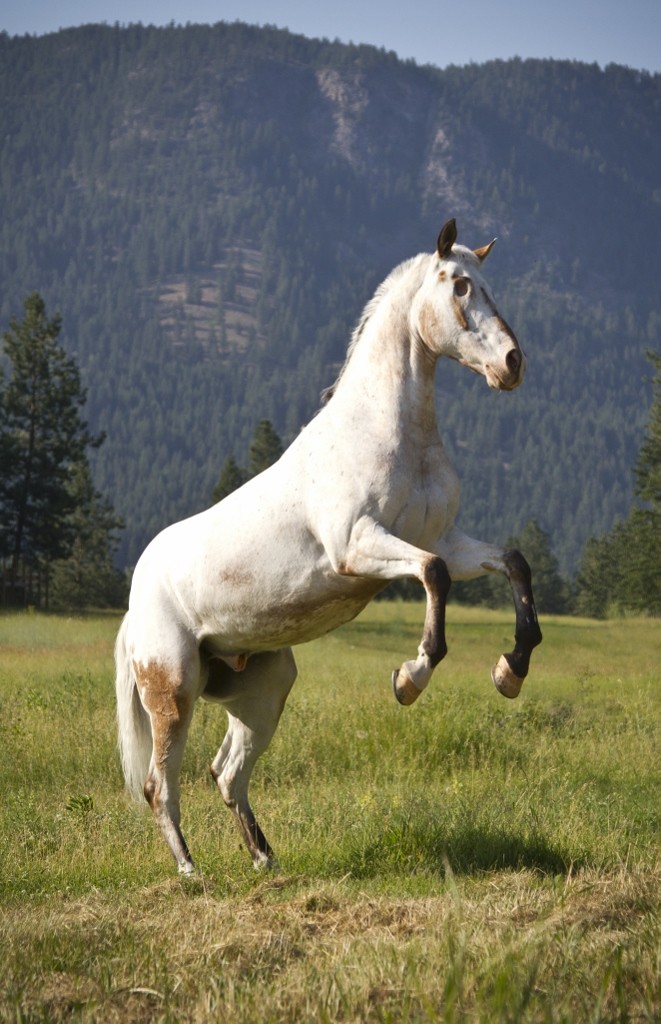The Care and Training of One Extraordinarily Special Needs Horse
by Catherine Madera and Morgan Wagner

I first saw them in Albany, OR, at the Northwest Horse Fair and Expo: a young woman calmly cantering around a working equitation course on her totally eye-less Appaloosa. It was simply unbelievable so after the demonstration I made my way to Endo’s stall and met his lifelong owner Morgan Wagner. The following include some of the questions I just had to know about not only caring for, but riding, a completely blind horse. I hope you are inspired by their amazing partnership.
Question: How did you meet Endo, and when did he lose his sight?
Answer: My grandma bred Appaloosa and Quarter Horses at her small farm in the Willamette Valley. When I was 13 she let me choose one of her foals and I specifically chose Endo because he just had a different presence and character from the other babies. He was my very first horse. Back then I knew absolutely nothing about handling horses since I didn’t grow up with them so Endo and I learned everything together. I started riding him when he was around three. He is 15 now and I am 28. With money always very tight, I did not have the ability to get formal lessons, but that didn’t stop us from trying everything we could at home from trail riding to gaming.
Endo’s lost his sight slowly and around age 12 the uveitis flare-ups worsened. His eyes were weepy, swollen and very painful. Our vet prescribed Bute and a daily dose of aspirin, but the medication made Endo lose his appetite. Then his eye tissues started hemorrhaging; that’s when I made the decision to remove his eyes. He needed to be happy, even if he might not be rideable anymore.
Question: Was there any specific advice vets gave you about living with a blind horse?
Answer: The vets didn’t have a lot of experience with completely sightless horses. They recommended I take extra precautions with his surroundings and resume his normal routine as soon as possible. I think the commonly held belief is that blind horses just can’t do much once their sight is gone. Endo has shown me how adaptable horses really can be; they are continually able to learn new things and push the limits of what is thought possible. Endo still surprises me almost daily. Lately he has gotten very good at quickly figuring out not just where gates are, but how to open and get through them too.
Question: You didn’t know if he would be rideable without eyesight. Tell us some of the challenges you’ve encountered and what you do to give him a secure life now?

Answer: The first thing I had to do was dispel the notion that Endo could not have a normal and happy life if he was blind. I began by researching as much as possible online, but found it difficult since the term “blind” covers a whole spectrum, from somewhat blind to completely blind. I’ve found there is a huge difference between partial or limited vision and true blindness when there is no eye function at all. When Endo’s eyesight was going bad he still was able to see shapes and light and dark to keep himself somewhat oriented. After he lost 100% of his vision he was suddenly and completely cut off from the world visually and had to relearn many things. His loss of balance was alarming to us both, and pretty disheartening at first. We worked together getting him to regain balance and I think we both began to have renewed confidence. At first I hated even leaving him alone in his stall, but even just a few hours after surgery he began moving around like a sighted horse. The next step was to see how he would handle his pasture. He was tentative at first, but became remarkably bold outside, learning to smell, feel and hear his way around obstacles such as trees and fencing.
It’s just remarkable watching Endo with other horses. My other two join him to play occasionally and little things are different. For instance, Endo now goes up more than forward when he leaps about, and often stops to cock his head and listen. Sometimes we have to rein it in just a little bit if he gets overconfident, but when he slows down and uses his ears, nose and sense of touch he can work his way through almost anything. Watching him with other horses has taught me a lot about how horses communicate, too, like how they take cues from each other’s breathing. I’m always learning things from Endo. As far as giving him a full and secure life, we are with each other most days and he gets a lot of time to just be a horse!
Question: What kind of riding and showing do you do with Endo?

Answer: Last year was Endo’s first time being a show horse. We did a few trail, gaming and schooling shows in addition to the working equitation shows. He could smell the strange new obstacles at the events and it was quite a challenge the first few shows; this was in addition to him being nervous about what the other horses were doing. Still, it didn’t take him long to understand what was going on. Endo particularly loves the speed phase when he can just run full throttle. Last September we competed in Las Vegas for the Andalusian World Cup, which was very intense. We performed in the working equitation portion that was open entry to all breeds. We didn’t place first, but I learned a lot from that experience. We are returning to Las Vegas at the end of September this year and then heading to Texas for the Haras Cup. We also just finished performing in “The Night’s Mare” at Caravan Farm Theatre in Canada. This was Endo’s first theatrical performance and was an amazing experience. I will always have fond memories of the wonderful community there and how supportive they were of Endo.
Endo can get very bored with riding work every day so we have a day or two playing together each week and mix it up with tricks and liberty work. Re-teaching him liberty work really helped him relearn how to balance before I was able to ride him. The voice tricks also helped us make the switch from sighted to no eyes and set up the groundwork for learning new voice commands to help him navigate obstacles and, later, even jumps.
Question: Traveling with a totally blind horse brings up a host of questions about safety. Can you elaborate on your routine with Endo?
Answer: Endo’s safety and comfort are top priority. To load into a trailer for traveling, for instance, I have taught him to lift his leg on command to step up into the trailer (this also works for obstacles we come across). He prefers slant load trailers for maintaining his balance so I try to be aware of those types of things and accommodate him when I can. Anytime he goes into a new stall, I guide him around the walls using his halter to show him he is in a stall. At first he was especially nervous about being left alone in a new place. The solution I came up with is to walk away a short distance and come back to him and gradually increase the distance and time I’m away until he is comfortable with me leaving for hours at a time.
Question: You were diagnosed with lupus. Does this help you relate to Endo and his “disability”?
Answer: In a way Endo saved me by helping me out of a dark place in my life. Instead of depression or hopelessness in my condition, I watched him carry on day-to-day, always exploring new places without fear. Despite his limitations, Endo just moved forward as best he could and never gave up. This has had a profound effect on me.
Thank you Morgan; you both are simply amazing! To learn more about this special team and see video of Endo visit their Facebook page: Endo the Blind Horse.
Published in October 2015 Issue

Catherine Madera served as editor of the Northwest Horse Source for five years. She has written for numerous regional and national publications and is a contributing writer for Guideposts Magazine and the author of four equine-related books. She has two grown children and lives with her husband and three horses in Northwest Washington.





